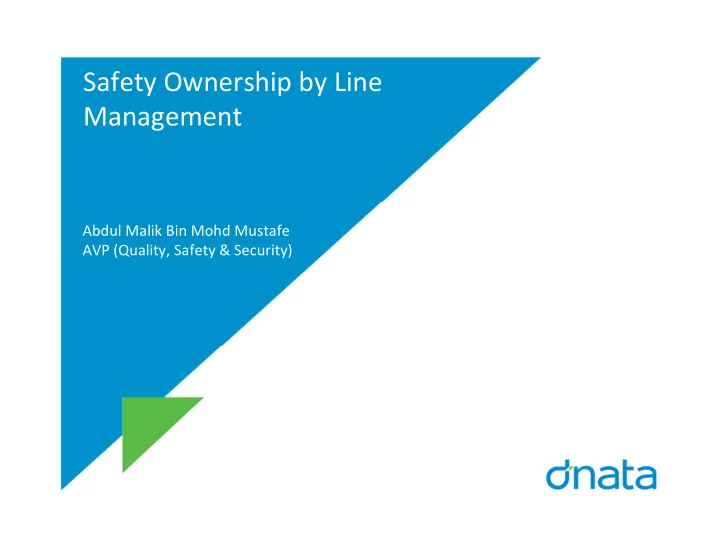

Safety Ownership by Line Management Abdul Malik Bin Mohd Mustafe AVP (Quality, Safety & Security)
Overview Framework – Leadership & Safety Culture Line Management - Incident Management Line Management - Hazard & Observation Programme Line Management - Engagement
dnata 60 years of history, global footprint in above 60 countries, servicing nearly 300 airlines in about 130 airports Ground Handling, Cargo, Catering & Travel Singapore – Ramp, Baggage, Passenger, Cargo, Load control & Flight Operations, Lounge & Catering
Framework - Leadership & Safety Culture
Safe Place + Safe Person
Safe Place + Safe Person
One Safety Program Changing the Mindset –Safety is somebody’s job. OTP is my job. One Safety Program was launched internationally in May 2013 A ‘culture change’ programme One Safety Program aimed at changing organisational culture to improve safety performance, moving closer to ‘zero harm’ workplace. It is about engaging all employees and contractors to adopt good leadership and teamwork by reinforcing safe habits through observations and feedback
Safe Leaders & Safe OTP Instilling safety leadership practices from front line supervisors to senior executives, so that we can build a culture of commitment towards safety Providing leaders with skills and knowledge to become an effective Safety Leader Classroom training and on the job coaching by Safety Coach
Leadership Visibility Index “Leaders create and change cultures, while managers and administrators live within them.” – -Edgar Schein
dnata SPI’s LEADING
Incident Management
Incident Management Investigation of incidents is a line management responsibility. All dnata work-related incidents are to be investigated by dnata operational managers and supported where necessary by a dnata Safety Specialist and other specialist advisers.
Incident Management – Operational Managers Apply the dnata Incident management and Investigation procedures Approve CAPA and reports Ensure the incident notification process is applied Provide technical expertise to investigations Applying just culture framework to decisions on staff performance
Incident Management - Operational Supervisors Rigorously apply incident notification process Ensure HSE incidents are reported Develop CAPA and obtain appropriate approvals Perform initial classification of incidents as per the RAM Perform Level 1 investigations
dnata SPI’s LEADING
Hazard & Observation Programme
STOP Observation Programme STOP Observation Programme is primarily a • communication and interaction tool which allows for an informal assessment of work activities and workplaces, performed by any and all staff. Overall goal of the programme is reducing the • likelihood of an incident by reducing the number of unsafe acts, identifying and controlling unsafe conditions, and promoting positive behaviours or best practices.
STOP Observation Programme STOP reinforces intervention by encouraging all • employees that if they see something, say something. The monitoring of timely action closeout leads to a safe • place/safe person and the trending allows for systemic problem solving.
Operational Managers - STOP Management Actively participate in the observation programme Visibly promote reporting of unsafe acts or unsafe conditions Positively convey appreciation for reporting of unsafe acts or unsafe conditions Monitor recorded actions to close in timely manner Conduct periodic review of the process and follow-up on elevated observations
Operational Supervisors - STOP Management Ensure immediate close out of actions in the observation register Coordinate with employees to ensure observations are conducted Conduct Observations Share the trend analysis observations to operational staff Escalate observations to operational managers based on the significance of the observation
Engagement
Communication & Engagement Engaging our people at all levels of the organization in continuous improvement and change initiatives to constantly review and improve safety at the workplace Leadership Safety Briefings Safety Promotion/Safety Campaign Recognition
Engagement
What do Staff think? Employees today are more aware of Safety Employees provide good feedback on safety issues Employees more diligent in use of PPE Safety discussed frequently
Challenges • Culture • OTP mentality • Somebody else’s job • Training
Thank you.
Recommend
More recommend